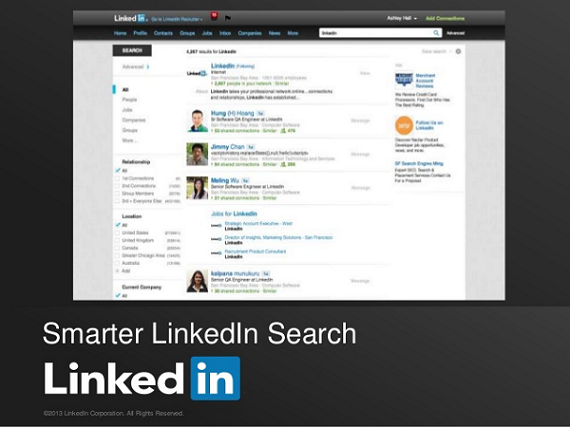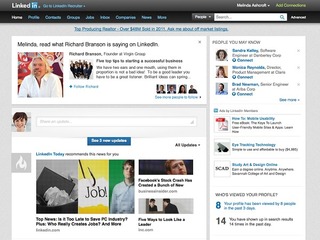

Probably the first thing any of us did, and anyone will ever do, on the Internet was search for something. I remember back when I was in elementary school, probably around 1995 or 1996, going to the library and being shown how to use Google. (In case you were wondering, the project had something to do with Homer the poet, but all of my searches kept coming up with references to Homer Simpson!)
Just how fundamental is search to being successful as an Internet property? In this short year, three social networks have revamped their search features to make them broader and easier to use.
The latest to do so is LinkedIn, which announced Monday that it has updated its search capability with a host of new features and capabilities.
“We’ve unified the search experience so you no longer need to search for people, companies, or jobs separately. Now, all you need to do is type what you’re looking for into the search box and you’ll see a comprehensive page of results that pulls content from all across LinkedIn including people, jobs, groups and companies,” Johnathan Podemsky, Product Manager at LinkedIn, wrote.
In addition, LinkedIn added five new features: auto-complete; suggested searches; a smarter algorithm that “learns and understands your intent over time” so that it can provide more relevant results; enhanced advanced searches, which can be filtered through location, company, school, etc; and automatic alerts that will save searches and alert users when the results change.
“No two professionals are alike on LinkedIn. This means even if you search for the same thing as someone else, your results will be customized to you. LinkedIn’s search efforts are founded on the ability to take into account who you are, who you know, and what your network is doing to help you find what you’re looking for,” Podemsky wrote.
The new search will begin to roll out to LinkedIn members today and will be available to all global members in the coming weeks.
Social networks and searching
LinkedIn has good reason to update its search capabilities: not only were 5.7 billion professionally oriented searches done on LinkedIn last year, but it has to keep up with its rivals, like Twitter and Facebook, both of which recently announced that they too were making search a priority.
Last month, Twitter announced new features in regards to how users are able to search on its app for iOS, Android and mobile Web.
It added a discover tab to shows all content, including Tweets, Activity, Trends and suggestions of accounts to follow, in a single stream, as well as a new search button on the iPhone app, which was already available on Android and iPhone, so that users can search from anywhere with in the app. It also updated the Connect tab to open automatically to Interactions, which will show users new followers, retweets and mentions.
Facebook’s entrance into the world of search was even more dramatic, with the launch of Graph Search in January. Graph Search is designed to gather information about people, as opposed to Web search, which gathers information about things.
For example, a user can search for information about a singer or a movie on regular Web search, but on Graph Search they can find out who likes that singer or that movie, based on content and information that has been shared on the network. If those people have the same interests as that user, then they can use that information as a recommendation for what to watch.
One of many new products
There is another reason for LinkedIn to improve search: its steady stream of innovation served it extremely well last year, and it needs to continue the same pace this year.
In its latest quarter, LinkedIn posted non-GAAP earnings per share of 35 cents on revenue of $303.6 million, up 81% from $167.7 million in the year-ago period, and well above the consensus estimates compiled by Thomson Reuters of 19 cents a share on revenue of $279.5 million.
In a call following the release of those numbers, LinkedIn CEO Jeff Weiner said a big part of the company’s success was due to to the large number of new products the company had put out, including endorsements, and from an accelerated product schedule, from once every two weeks to twice a day.
In July, the site redesigned its homepage to allow members to “discover, share and discuss the professional information that is most relevant to them.” Homepage page views are up 70% since the redesign.
The company also came out with “influencers,” which were introduced in October, to make the service a professional publishing platform. The most popular influencer is Richard Branson, with over 1.3 million followers. In October, LinkedIn also introduced an updated profile.
Earlier this month, LinkedIn endorsement passed one billion in six months.
Updating search will be important, not just for keeping up with other social networks, but with keeping up LinkedIn’s own innovative pace.
(Image source: http://blog.linkedin.com)























